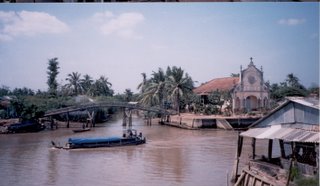Ho Chi Minh City - Can Tho

I love the above picture.
Perhaps it looks a little staged, but it captures the essence of the Mekong Delta I think. First there's the Delta itself. A vast interconnected, tree-like branching system of tributaries which lazily empty themselves into the South China Sea along hundreds of miles of Vietnam's coastline. The water is a muddy brown colour, barely moving, occasionally rippled by the wildfowl or passing boats. This, coupled with the constant hot gaze of the sun on the river -- never shielded by the low lying scrub on the banks -- gives the whole place a very laidback, timeless feel. It's easy to while away the ride sunbathing on the roof of your boat, or reading in the shaded section beneath, dipping your hand in the water from time to time.
All along the banks, spaced a good deal apart, are the local's houses. Like the one in the foreground of the picture, they are usually makeshift structures made from corrugated aluminium sheets, and perch precariously over the river, supported by wooden stilts that disappear into the silty water. The children often wave and run along side as you pass.
On the far side a Catholic church is the most well-built building in the area. It is another reminder of the complexity of Vietnam's history, and the power and range of religious belief here. As well as mainstream creeds like Buddhism, Confucianism, Taoism and Christianity, there are smaller sects such as the Cao Dai, and also worship centered around spirits in animals, plants, and other parts of nature.
To get to our destination, Can Tho -- a bustling city in the heart of the Delta -- by nightfall, we left HCMC at 8am sharp. The guide, seated at the front of the coach, began a long monologue about various places along the route out of the city, but quickly gave-up when he realized most the passengers weren't listening and trying to get some extra sleep.
After transfer to boat we paid a brief visit to a coconut sweet factory on one of the thousands of islets that pepper the Mekong Delta region. I understand why these Third World factory tours happen: because the factory owners can make extra money from entrance fees and sales off tourists.
What I don't understand so well is what the tourist gets out of it.
There is no way of knowing whether this factory tour is representitive of general conditions across the country. In fact, there are reasons to believe it isn't and might well show much happier workers with much better working practices than the norm. If that is the case, then visitors can come away with a completely misguided view of the labor market. And it is doubly pernicious because it undermines various agencies efforts to publicise the consequences of global trade, and it makes these tourists, average consumers back home, more complacent about what their lifestyle entails for workers in the Third World.
If you're going to visit a workplace in a foreign land, you have a much better chance of seeing a true picture if you randomly pick a business and just ask to be shown around.
Upon arrival in Can Tho it transpired that the booked hotel didn't have enough rooms for the entire party. We were split-up into various groups and scattered around the town. Sneakily, I had prevaricated so that I got placed with a trio of English girls who had met at Middlesex Uni and were travelling around the world together. We went out for dinner together and talked about London, relationships and student days. Travelling, away from familiar people, places and routines, seems to be a good way of moving on at the end of a relationship.



0 Comments:
Post a Comment
<< Home